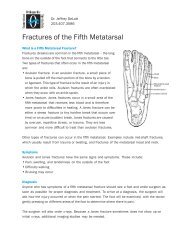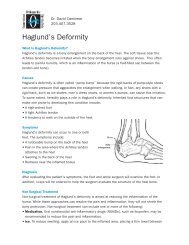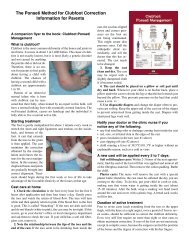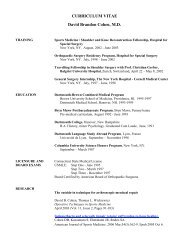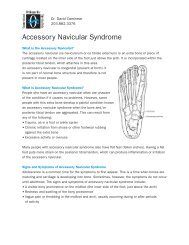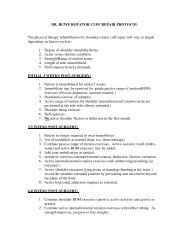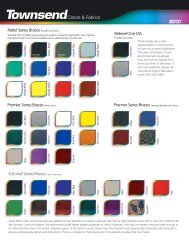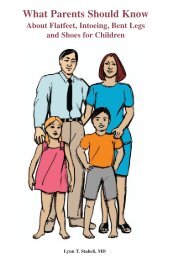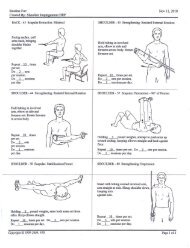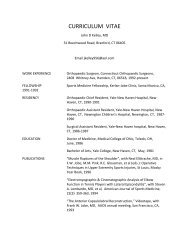Ingrown Toenail - CT-Ortho.com
Ingrown Toenail - CT-Ortho.com
Ingrown Toenail - CT-Ortho.com
- No tags were found...
Create successful ePaper yourself
Turn your PDF publications into a flip-book with our unique Google optimized e-Paper software.
Dr. Eliza Addis-Thomas203.407.3515<strong>Ingrown</strong> <strong>Toenail</strong>What Is an <strong>Ingrown</strong> <strong>Toenail</strong>?When a toenail is ingrown, it is curved and growsinto the skin, usually at the nail borders (the sidesof the nail). This “digging in” of the nail irritates theskin, often creating pain, redness, swelling, andwarmth in the toe.If an ingrown nail causes a break in the skin,bacteria may enter and cause an infection in thearea, which is often marked by drainage and a foulodor. However, even if the toe isn’t painful, red, swollen, or warm,a nail that curves downward into the skin can progress to an infection.CausesCauses of ingrown toenails include:• Heredity. In many people, the tendency for ingrowntoenails is inherited.• Trauma. Sometimes an ingrown toenail is the resultof trauma, such as stubbing your toe, having an objectfall on your toe, or engaging in activities that involverepeated pressure on the toes, such as kicking orrunning.• Improper trimming. The most <strong>com</strong>mon cause ofingrown toenails is cutting your nails too short. Thisencourages the skin next to the nail to fold over the nail.• Improperly sized footwear. <strong>Ingrown</strong> toenails can result from wearing socks and shoes thatare tight or short.• Nail Conditions. <strong>Ingrown</strong> toenails can be caused by nail problems, such as fungal infectionsor losing a nail due to trauma.TreatmentSometimes initial treatment for ingrown toenails can be safely performed at home. However,home treatment is strongly discouraged if an infection is suspected, or for those who havemedical conditions that put feet at high risk, such as diabetes, nerve damage in the foot, orpoor circulation.
Home care:If you don’t have an infection or any of the above medical conditions, you can soak your foot inroom-temperature water (adding Epsom’s salt may be re<strong>com</strong>mended by your doctor), and gentlymassage the side of the nail fold to help reduce the inflammation.Avoid attempting “bathroom surgery.” Repeated cutting of the nail can cause the condition toworsen over time. If your symptoms fail to improve, it’s time to see a foot and ankle surgeon.Physician care:After examining the toe, the foot and ankle surgeon will select the treatment best suited for you.If an infection is present, an oral antibiotic may be prescribed.Sometimes a minor surgical procedure, often performed in the office, will ease the pain andremove the offending nail. After applying a local anesthetic, the doctor removes part of the nail’sside border. Some nails may be<strong>com</strong>e ingrown again, requiring removal of the nail root.Following the nail procedure, a light bandage will be applied. Most people experience very littlepain after surgery and may resume normal activity the next day. If your surgeon has prescribedan oral antibiotic, be sure to take all the medication, even if your symptoms have improved.Preventing <strong>Ingrown</strong> <strong>Toenail</strong>sMany cases of ingrown toenails may be prevented by:• Proper trimming. Cut toenails in a fairly straight line, and don’t cut them too short. Youshould be able to get your fingernail under the sides and end of the nail.• Well-fitted shoes and socks. Don’t wear shoes that are short or tight in the toe area. Avoidshoes that are loose, because they too cause pressure on the toes, especially when runningor walking briskly.What You Should Know About Home Treatment• Don’t cut a notch in the nail. Contrary to what some people believe, this does not reduce thetendency for the nail to curve downward.• Don’t repeatedly trim nail borders. Repeated trimming does not change the way the nailgrows, and can make the condition worse.• Don’t place cotton under the nail. Not only does this not relieve the pain, it provides a placefor harmful bacteria to grow, resulting in infection.• Over-the-counter medications are ineffective. Topical medications may mask the pain, butthey don’t correct the underlying problem.



